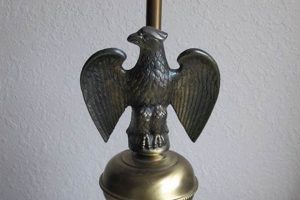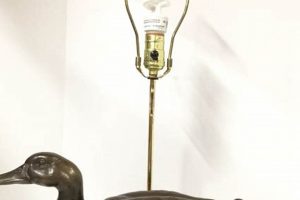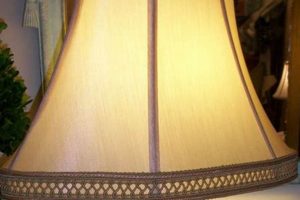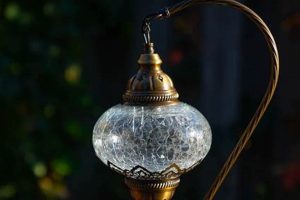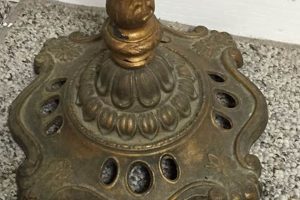Illuminating miniature decorative lights, often crafted during the Victorian era, held small candles or oil lamps within a colored glass shade, producing a soft, diffused glow. These lights, sometimes referred to as veilleuses or night lights, were intended for use in nurseries, bedrooms, and hallways to provide a gentle source of light throughout the night. Examples include Clarke’s pyramid lamps and similar designs produced by various glass manufacturers.
The significance of these antique lighting pieces lies in their delicate craftsmanship, the artistry of the glasswork, and their historical association with a time when electricity was not commonplace. They represent both a functional item and a decorative object, reflecting the aesthetic sensibilities of a bygone era. Their gentle light offered a sense of comfort and security, serving a purpose beyond mere illumination.
Examination of the materials, manufacturing techniques, identifying marks, and variations in design are crucial to appreciating these historical items. Subsequent sections will explore the identifying characteristics, popular manufacturers, and conservation strategies associated with these charming relics.
Tips for Appreciating and Preserving Historical Miniature Illumination
The following guidelines are intended to aid in the identification, evaluation, and responsible preservation of these delicate historical lighting objects. Applying these principles can help ensure their continued appreciation for future generations.
Tip 1: Examine Glass Composition and Manufacturing Techniques: Careful observation of the glass is critical. Look for pontil marks, mold seams, and irregularities indicative of hand-blown or early manufacturing processes. Variations in color and clarity can offer clues about the glassmaker and era of production.
Tip 2: Identify Maker’s Marks Where Possible: Many examples bear maker’s marks, often found on the base or collar. Researching these marks can provide definitive information about the origin and age of the piece. Sources such as glass manufacturer directories and antique reference books are essential.
Tip 3: Assess Condition Carefully: The condition significantly impacts value and preservation efforts. Note any chips, cracks, or repairs. Originality of the components, including the shade, base, and burner, is paramount.
Tip 4: Consider the Form and Design: The shape, decoration, and design elements can indicate a specific manufacturer, period, or style. Familiarity with common forms, such as pyramid, fairy, or cranberry shades, is beneficial.
Tip 5: Regulate Storage Conditions: When not on display, store items in a stable environment away from direct sunlight, extreme temperatures, and humidity. Acid-free tissue paper and padded containers can help prevent damage.
Tip 6: Employ Gentle Cleaning Methods: Use only soft, lint-free cloths and distilled water for cleaning. Avoid harsh chemicals or abrasive cleaners, as these can damage the glass surface or remove delicate painted details.
Tip 7: Document Provenance: Maintain a record of the object’s history, including where it was acquired, any known previous owners, and any relevant documentation. This information can significantly enhance its historical value and authenticity.
Tip 8: Use Proper Lighting: When displaying, use low-wattage LED lighting to avoid heat damage. The original purpose of these items was gentle light, and modern lighting should respect that.
By adhering to these guidelines, collectors and enthusiasts can ensure the longevity and continued appreciation of these historical lighting treasures. Knowledge and careful handling are key to preserving their beauty and historical significance.
The following sections will provide specific information regarding particular manufacturers and conservation strategies, enabling a deeper understanding and appreciation for these captivating relics.
1. Glass type and color
The composition and hue of the glass used in construction are fundamental attributes that significantly influence the value, aesthetic appeal, and historical context of an antique miniature light. Analysis of these properties provides crucial insights into the manufacturing techniques, era of production, and potential origin of the object.
- Glass Composition and Clarity
The type of glass used, whether leaded crystal, soda-lime glass, or other formulations, affects its clarity, refractive properties, and weight. Leaded crystal, known for its brilliance, was frequently employed in higher-quality examples. Impurities or deliberate additives in the glass batch contribute to unique colorations and opacities. Examining the glass for bubbles, striations, or other imperfections reveals manufacturing processes and helps distinguish hand-blown from mass-produced items. For instance, “vaseline glass,” known for its uranium content and distinctive yellow-green glow under ultraviolet light, is a desirable type.
- Color Pigmentation Techniques
The methods used to introduce color into the glass provide clues about the manufacturing era and the glassmaker’s skills. Colors could be achieved through various techniques, including adding metallic oxides to the glass batch (e.g., cobalt for blue, manganese for purple), applying surface stains, or using flashed glass (a thin layer of colored glass applied over a clear glass base). The intensity and uniformity of the color are indicators of the quality of the glassmaking. For example, cranberry glass, achieved by adding gold chloride, is often highly sought after due to its rich color and the cost of the materials used.
- Influence on Light Diffusion
The color and translucency of the glass significantly affect the quality and intensity of the light emitted. Deeply colored glass, such as ruby or emerald green, creates a warm, subdued glow, while lighter shades, like opalescent or clear glass, allow for brighter illumination. Opaque glass diffuses the light more evenly, preventing harsh shadows. Understanding how different glass types interact with light is crucial for appreciating the intended ambiance of the piece. For instance, a heavily frosted shade made from custard glass diffuses light softly and evenly.
- Authenticity and Dating
Certain glass colors and techniques are associated with specific historical periods. For example, Burmese glass, characterized by a gradient of peach to yellow achieved through reheating, was popular in the late Victorian era. Recognizing these color trends and matching them to known manufacturing dates helps in establishing the authenticity and approximate age of a piece. The presence of certain color combinations or glass formulations can either confirm or refute claims about its provenance.
In summary, the glass type and color are critical identifiers, influencing the aesthetic qualities and providing essential data for authentication and historical placement. These factors, when carefully analyzed, offer a deeper appreciation of the artistry and craftsmanship involved in the creation of each miniature light.
2. Manufacturer identification marks
The presence and analysis of manufacturer identification marks are indispensable to establishing the authenticity, origin, and historical value of antique miniature lights. These marks, typically etched, stamped, or molded into the glass or metal components, serve as crucial evidence for tracing the lineage and production of these delicate objects.
- Types of Marks and Placement
Identification marks manifest in several forms, including full company names, initials, logos, or registry symbols. These are often found on the base, collar, or underside of the shade. Clarke’s, for example, prominently marked their wares with a pyramid symbol and the company name. The location and style of the mark can offer clues about the period of production and the specific manufacturing process employed.
- Importance in Authentication
Manufacturer marks serve as primary evidence in verifying the authenticity of antique lighting. Comparing observed marks with documented records of known manufacturers is essential to differentiating genuine pieces from later reproductions or forgeries. The absence of a known mark does not automatically indicate illegitimacy, but it necessitates a more rigorous examination of other characteristics, such as glass composition and construction techniques.
- Dating and Historical Context
The style and form of manufacturer’s marks can also provide valuable insights into the dating of the piece. Companies often changed their logos or marking conventions over time. Researching the history of a specific manufacturer, including changes in their branding, can help narrow down the period of production with greater accuracy. For example, a shift from embossed lettering to etched marks might indicate a transition in manufacturing technology.
- Determining Value and Rarity
The presence of a clear and identifiable manufacturer’s mark significantly impacts the perceived value and desirability of these lights. Objects produced by well-known and highly regarded manufacturers, such as Baccarat or Webb, typically command higher prices in the antique market. Rarer marks, or those associated with limited-edition designs, further enhance the collectible appeal and value of the item.
In conclusion, diligent examination and accurate interpretation of manufacturer identification marks are critical for collectors, researchers, and historians seeking to understand and appreciate these historical lighting pieces. These marks serve as a direct link to the past, providing verifiable evidence of origin and contributing to a more comprehensive understanding of their historical context and aesthetic significance.
3. Original burner components
The integrity and presence of original burner components are paramount when evaluating the authenticity and historical value of these antique miniature lights. These components, designed specifically to accommodate the fuel source (typically a candle or oil), are integral to their function and provide critical insights into the manufacturing period and intended use.
- Design and Materials
The design of the burner varies depending on the intended fuel source and the manufacturer. Candle burners often consist of a simple socket or cup to hold the candle, while oil burners incorporate a wick holder and a fuel reservoir. Materials used range from brass and copper to tin and glass. Original components exhibit characteristics consistent with the manufacturing techniques and materials prevalent during the item’s creation, offering crucial clues to authentication.
- Functionality and Safety
Burner design directly affects the functionality and safety. Proper ventilation, wick height adjustment, and secure attachment to the base are essential for safe and efficient operation. Original burners were carefully engineered to provide a steady, controlled flame while minimizing the risk of fire. The presence of original components assures a closer representation of the item’s intended function and illumination.
- Manufacturer Specifics and Markings
Some manufacturers, such as Clarke’s, incorporated unique design features or markings on their burners. These features serve as valuable identifiers, linking the burner to a specific maker and authenticating the entire piece. Examination of burner markings, patent numbers, and construction details can corroborate the burner’s origin and period.
- Impact on Value and Collectibility
The presence of original burner components significantly increases the item’s value and desirability among collectors. A complete and unaltered example, retaining its original burner, is considered more historically accurate and representative of its time. Replacement burners, even if period-appropriate, diminish the item’s authenticity and, consequently, its value.
In summary, the study and appreciation of original burner components are essential for authenticating, dating, and valuing antique miniature lights. Their design, materials, and markings offer verifiable evidence of origin and function, providing a tangible link to the history and craftsmanship of these charming relics.
4. Shade design variations
The design variations observed in shades constitute a defining characteristic of antique miniature lights. These variations, encompassing shape, color, material, and decorative elements, reflect the aesthetic sensibilities of the period and the manufacturing techniques employed. Understanding these nuances is crucial for accurate identification and appreciation.
- Form and Silhouette
The silhouette of the shade significantly contributes to the overall aesthetic. Common forms include conical, bulbous, and pyramidal shapes, each influencing light diffusion differently. Variations in the curve and angle of the shade impact the projection and intensity of the light. Examples include the sharply angled Clarke’s pyramid shades and the more rounded forms seen in some cranberry glass lights. These shapes are indicative of different eras and manufacturing approaches.
- Glass Composition and Coloration
The type of glass and its coloration dramatically alter the light emitted. Shades were crafted from clear, colored, or opalescent glass, each offering a distinct visual effect. Color was achieved through various techniques, including the addition of metallic oxides. Cranberry glass shades, for example, impart a warm, rosy glow, while blue shades create a cooler ambiance. The choice of glass type and color was often deliberate, reflecting the intended use and aesthetic preferences.
- Surface Decoration Techniques
Surface decorations enhance the visual appeal and provide clues about the maker and period. Techniques included hand-painting, enameling, acid-etching, and the application of raised textures. Floral motifs, geometric patterns, and figural scenes were common. The quality and intricacy of the decoration directly influence the value and collectibility. Shades adorned with elaborate hand-painted details, for example, command higher prices than those with simple designs.
- Ventilation and Heat Dissipation Features
The inclusion of ventilation features, such as holes or openings, served a practical purpose: to dissipate heat generated by the candle or oil lamp. These features vary in design and placement, often integrated discreetly into the overall aesthetic. The presence and design of ventilation demonstrate an understanding of safety and functionality, influencing the longevity of the object and its suitability for prolonged use. The absence of adequate ventilation can lead to heat damage and cracking.
In conclusion, the diverse shade designs demonstrate the artistry and technical skill involved in the creation of antique miniature lights. Each variation in form, color, decoration, and ventilation reflects a specific aesthetic preference and manufacturing approach. By carefully examining these design elements, a deeper understanding and appreciation of these historical objects can be achieved.
5. Overall structural integrity
In the context of antique miniature lights, the evaluation of overall structural integrity is paramount. These delicate objects, often fabricated from fragile materials such as glass and thin metal, require careful assessment to ascertain their condition and historical value. Structural soundness dictates not only the longevity of the item but also its authenticity and representational accuracy relative to its original design.
- Glass Shade Condition
The presence of cracks, chips, or repairs in the glass shade is a critical indicator of structural integrity. Even minor imperfections can compromise the shade’s stability and aesthetic appeal. Cracks can propagate over time due to temperature fluctuations or physical stress, leading to further damage. Repairs, while potentially stabilizing the structure, often detract from the item’s historical value unless professionally executed and minimally invasive. For example, a hairline crack in a cranberry glass shade significantly reduces its value compared to an undamaged example.
- Base Stability and Material Fatigue
The base of the miniature light provides the foundation and support for the shade and burner. Instability, resulting from corrosion, warping, or breaks, undermines the overall structural integrity. Metal bases, particularly those made of brass or tin, are susceptible to oxidation and fatigue over time. Wooden bases can warp or crack due to humidity changes. A wobbly or compromised base not only diminishes the item’s aesthetic appeal but also poses a safety hazard if it cannot adequately support the shade and burner assembly.
- Collar and Connector Integrity
The collar, which connects the shade to the base, is a critical component for maintaining structural integrity. Damage to the collar, such as cracks, dents, or loose connections, can compromise the stability of the entire assembly. The collar ensures the shade is securely and safely positioned above the burner. A loose or damaged collar can lead to misalignment or even detachment of the shade, increasing the risk of breakage or fire.
- Evidence of Past Repairs and Restorations
The presence and quality of previous repairs significantly impact the assessment of structural integrity. While repairs may stabilize the object, poorly executed or excessive restorations can detract from its historical value and authenticity. Evidence of glue residue, mismatched materials, or visible seams indicate previous interventions that alter the original structural integrity. A carefully restored miniature light, where repairs are discreet and materials are period-appropriate, retains more value than one with obvious or poorly executed repairs.
In summary, the overall structural integrity of vintage miniature lights is a multifaceted consideration, encompassing the condition of the glass shade, base stability, collar integrity, and the nature of any past repairs. A thorough evaluation of these factors is essential for determining the item’s authenticity, historical value, and potential for long-term preservation. Examples with intact, original components and minimal structural damage are generally considered more desirable and historically significant.
6. Historical decorative styles
Historical decorative styles are intrinsic to understanding the aesthetic appeal and cultural context of antique miniature lights. These lights, prevalent during the Victorian era and into the early 20th century, frequently mirrored the prevailing design trends of the time, making stylistic analysis a crucial component of their identification and evaluation. The decorative elements, ranging from floral motifs to geometric patterns, are not merely superficial adornments but rather reflect the artistic sensibilities, social values, and technological capabilities of their era. For instance, a miniature light featuring hand-painted roses and scrolling foliage exemplifies the romantic and naturalistic aesthetic prevalent during the mid-Victorian period. Similarly, examples incorporating geometric patterns and stylized designs may reflect the influence of the Art Nouveau movement, indicating a later period of production. The specific decorative techniques used, such as enameling or acid-etching, also provide valuable clues about the manufacturing processes and the skill of the artisans involved.
Further analysis reveals the practical significance of recognizing these stylistic connections. Accurate identification of the decorative style informs the dating of the piece, helps in attributing it to a specific manufacturer or region, and assists in assessing its relative rarity and value. Collectors and historians rely on these stylistic markers to differentiate authentic pieces from reproductions or later adaptations. Knowledge of the decorative arts also enhances appreciation of the miniature light as a microcosm of broader artistic trends. For example, the presence of Aesthetic Movement motifs, characterized by Japanese-inspired designs and a focus on beauty and craftsmanship, elevates the piece from a mere functional object to a reflection of a significant artistic and cultural movement. Similarly, the integration of Art Deco elements, such as geometric shapes and stylized patterns, signifies a shift toward modernity and industrial design.
In conclusion, historical decorative styles are an indispensable element in the study and appreciation of antique miniature lights. They provide a tangible link to the past, offering insights into the artistic tastes, technological capabilities, and cultural values of the eras in which these charming objects were created. The challenge lies in developing a comprehensive understanding of decorative arts history and applying this knowledge to the nuanced details of each piece. By recognizing and interpreting these stylistic markers, collectors and enthusiasts can gain a deeper appreciation for the historical significance and aesthetic beauty of vintage miniature lights.
7. Rarity and provenance
In the realm of vintage miniature lights, rarity and provenance are critical determinants of value and historical significance. The scarcity of a particular model, combined with a well-documented history of ownership and origin, elevates these items from mere collectibles to valuable artifacts, preserving a tangible link to the past. The interplay of these factors informs valuation, authentication, and overall appreciation.
- Scarcity of Design and Production
Certain miniature light designs were produced in limited quantities, either due to brief production runs, experimental manufacturing techniques, or the use of costly materials. A miniature light crafted by a lesser-known artisan or featuring a unique color combination may be exceedingly rare. The fewer examples available, the higher the demand and, consequently, the market value. Identifying rare variations requires extensive research, including consulting historical catalogs, auction records, and expert opinions.
- Documented Ownership History
Provenance, the documented history of ownership, adds layers of significance to vintage miniature lights. A clear chain of ownership, supported by bills of sale, letters, or family records, enhances the item’s appeal and credibility. If the miniature light can be traced to a notable historical figure or a prominent collection, its value increases substantially. Documented provenance provides a sense of connection to the past and ensures the authenticity of the object.
- Manufacturer’s Archives and Historical Context
Access to manufacturer’s archives, patent records, and historical documents provides invaluable insight into the production and distribution of miniature lights. These resources may reveal limited-edition releases, experimental designs, or collaborations with specific retailers. This contextual information not only confirms the authenticity of a piece but also enhances its historical narrative. Understanding the historical circumstances surrounding the creation and use of the light enriches its appreciation.
- Condition and Preservation State
Rarity is often intertwined with the condition of the item. If a rare design has survived in excellent condition, retaining its original components and finish, its value is significantly greater than a damaged or heavily restored example. The degree of preservation reflects both the care taken by previous owners and the durability of the materials used in its construction. A well-preserved, rare miniature light represents a tangible link to the past, offering a unique opportunity to appreciate the craftsmanship and aesthetic values of a bygone era.
In summary, rarity and provenance are intertwined factors that profoundly influence the value and historical importance of vintage miniature lights. Scarcity of design, documented ownership, historical context derived from manufacturer archives, and the item’s state of preservation all contribute to its desirability and collectible appeal. Understanding these elements elevates the appreciation of these enchanting relics beyond mere aesthetics, connecting them to a rich tapestry of history and craftsmanship.
Frequently Asked Questions
The following questions and answers address common inquiries and misconceptions regarding these historical lighting objects.
Question 1: What distinguishes a genuine antique miniature light from a reproduction?
Authenticity is determined by examining several factors, including glass composition, manufacturer’s marks, construction techniques, and decorative styles. Reproductions often exhibit modern manufacturing marks, different glass types, and deviations from historical designs.
Question 2: How should vintage miniature lights be cleaned and maintained?
Gentle cleaning with a soft, lint-free cloth and distilled water is recommended. Abrasive cleaners and harsh chemicals should be avoided, as they can damage the glass surface or remove delicate painted details. Proper storage involves protecting the item from direct sunlight, extreme temperatures, and humidity.
Question 3: What are the primary factors influencing the value of a vintage miniature light?
Value is determined by rarity, condition, manufacturer, glass type, decorative style, and provenance. Examples in excellent condition, produced by well-known manufacturers, and possessing documented historical ownership command higher prices.
Question 4: How can manufacturer marks aid in identifying and dating these objects?
Manufacturer marks, often found on the base or collar, provide crucial evidence of origin. Researching these marks and comparing them with historical records can reveal the manufacturer, production dates, and variations in design.
Question 5: What are the risks associated with using original burners in vintage miniature lights?
Original burners may pose safety hazards due to age and potential deterioration. They may not meet modern safety standards. Using these burners may increase the risk of fire or carbon monoxide emissions. It is advisable to exercise extreme caution or opt for safer, modern alternatives.
Question 6: How do different glass colors affect the light emitted by vintage miniature lights?
Glass color significantly alters the quality and intensity of the light. Deeply colored glass, such as ruby or emerald green, creates a warm, subdued glow, while lighter shades, like opalescent or clear glass, allow for brighter illumination. Opaque glass diffuses the light more evenly, preventing harsh shadows.
Proper identification, handling, and preservation techniques are essential for ensuring the longevity and continued appreciation of vintage miniature lights.
The subsequent sections will address specific case studies and advanced conservation methods.
Considerations Regarding Antique Miniature Lighting
The preceding exploration has underscored several key aspects of these miniature illuminants, including manufacturing techniques, material composition, and historical context. The multifaceted analysis, encompassing structural integrity, decorative elements, and verifiable provenance, contributes to a more comprehensive understanding of these objects. Identification, preservation, and valuation depend upon the diligent application of established criteria.
Continued research into the manufacturing processes, material science, and historical usage patterns will further refine our understanding. It is imperative that accurate historical data inform conservation efforts, contributing to the long-term preservation and appreciation of these enchanting relics for future generations.



